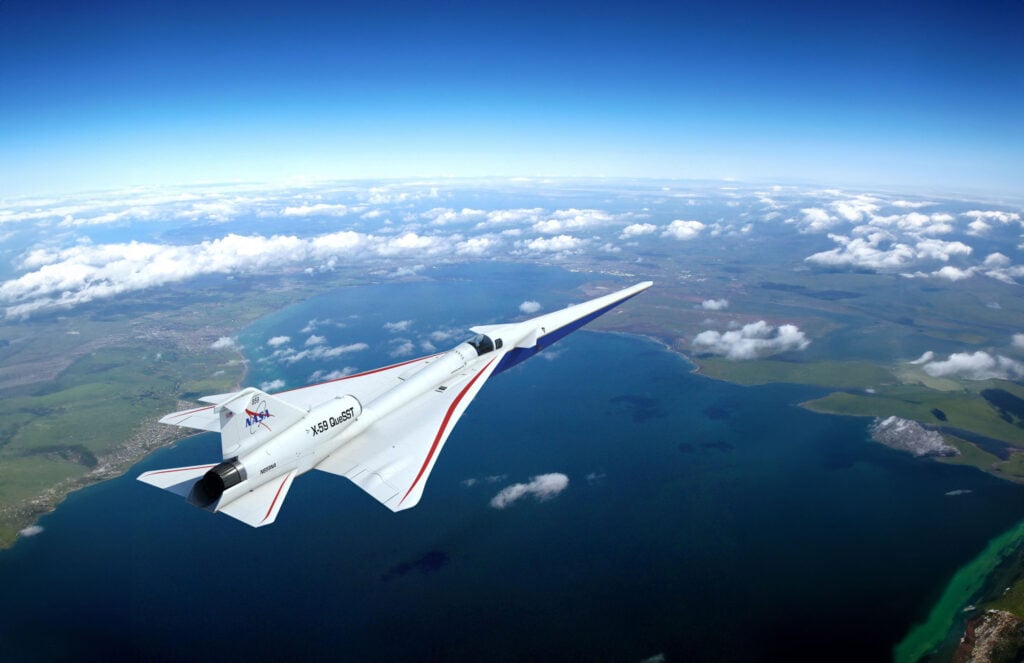Imagine flying from New York to London only to land across the pond in a mere 90 minutes. This hyper-fast future of air travel is approaching liftoff as NASA prepares its trailblazing X-59 jet for a history-making inaugural test flight.
Dubbed the “Son of Concorde,” NASA’s bullet-nosed X-59 is designed to cruise at 940 mph at 55,000 feet. Yet where the Concorde inaugurated the age of supersonic passenger travel in 1976, the latest generation adds a unique twist: a refined aerodynamic shape to produce shockwaves so quiet it aims to convince regulators to lift bans on supersonic flights over land.

The milestone first flight caps years of painstaking development and signals a future where eight-hour journeys across the Atlantic give way to intercity hops faster than some current flights across the continental United States. But first, the almost 300-foot-long X-59 needs to get airborne.
That day is a little closer as the aircraft recently moved to the flight line – the staging area readying planes for takeoff. But this is no ordinary roll to the runway, as evidenced by the plane’s shimmering new blue, white and red livery revealed last week. Beyond looking sharp, the striking paint scheme serves crucial functions. Specialised coatings safeguard the aircraft against moisture and buffeting winds, while high visibility markings aid ground crews and pilots. Engineers also carefully weighed paint amounts, cautious that even minor weight additions could impact range estimates.
The X-59 is nearing the final safety checks required before its engines ignite and wheels leave terra firma. Confirmed to handle smoothly at target speeds, teams will calibrate systems and rehearse protocols to prepare both pilots and evaluator crew members tasked with characterising the craft’s acoustic signature during supersonic flight.
The goal is not to set cross-Atlantic speed records but to demonstrate that sonic booms need not preclude supersonic travel over populated areas. To do so, it will cruise communities exuding gentle sonic “thumps” for resident participants to gauge loudness firsthand.
The X-59 has been specifically designed to reduce the loudness of sonic booms, allowing supersonic flight over land. This is achieved through its long, slender fuselage and canards that prevent shockwaves from amalgamating. The uniquely shaped airframe is 94 ft long with a 29.5 ft wingspan and should create a gentle 75 Perceived Level decibel thump on the ground.
Propulsion comes from a single General Electric F414 engine that enables a maximum speed of Mach 1.5. The aircraft will fly at Mach 1.42 or 940 mph at 55,000 ft for supersonic cruise. The afterburner-equipped powerplant generates 22,000 pounds of thrust to overcome drag. Since the pointed nose obstructs forward vision, Collins Aerospace’s Pro Line Fusion avionics include a 4K enhanced vision system displaying real-time footage and telemetry. Pilots will rely on this augmented graphical interface with a supplemental infrared camera for takeoffs and landings.
The cockpit has been transplanted from a T-38 trainer jet, and the rugged landing gear comes from an F-16 fighter. Ejection seats are installed as a safety measure during initial test flights of the experimental aircraft. NASA aims to gather community response data on the sound levels produced by the X-59. The information will support changing regulations to enable new overland commercial supersonic routes. Success could reconnect destinations like New York and London with 90-minute flights.
The public’s reaction is why NASA strains to develop the X-59 Quiet SuperSonic Technology aircraft, or QueSST. By carefully analysing feedback alongside the vehicle’s acoustic measurements, the data can help convince hesitant regulators that new noise-mitigation practices make supersonic passenger planes viable without unsettling thunderclaps from the skies.
Success could mean restarting rapid, sustainable flight programs that have been mothballed since the Concorde retired in 2003, with engineering expertise potentially attracting airframe orders to power an economic boon. Moving beyond one-off demonstrators, researchers ultimately envision routine Mach 2.0+ transports traversing oceans in half the time, or 1.5 hours between New York and London.
TLDR:
NASA developing a quiet supersonic passenger jet to fly from NY to London in 90 minutes
Existing regulations prohibit supersonic flight over land due to disruptive sonic booms
NASA’s X-59 jet will cruise at 940 mph to test “sonic thump” technology and convince regulators to change rules
Additional research underway for 2000+ mph concepts using exotic materials and engines
Significant obstacles remain but NASA initiative aims for 90 minute transatlantic flights by mid-century







